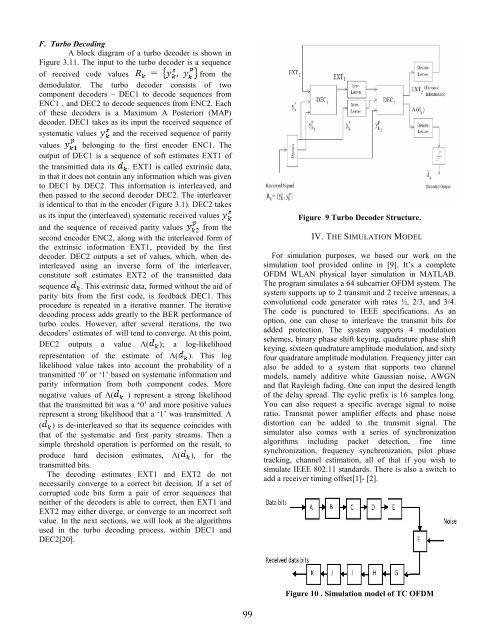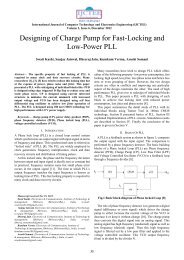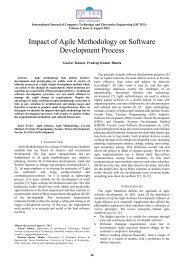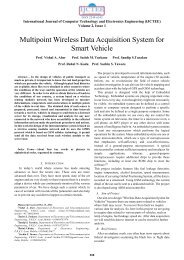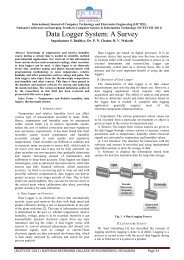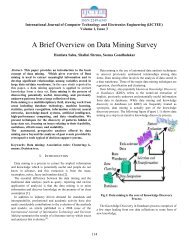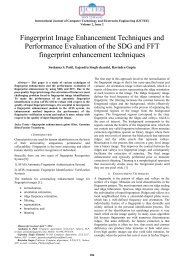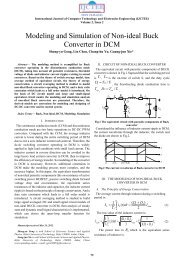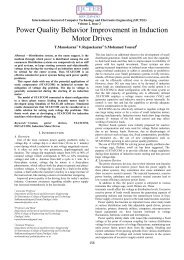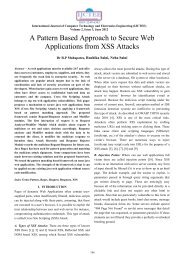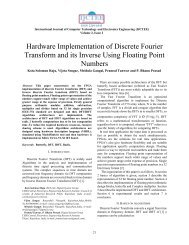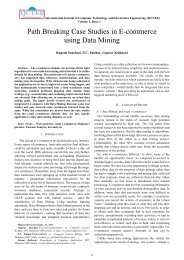Effect of Turbo Coding on OFDM Transmission to Improve BER
Effect of Turbo Coding on OFDM Transmission to Improve BER
Effect of Turbo Coding on OFDM Transmission to Improve BER
Create successful ePaper yourself
Turn your PDF publications into a flip-book with our unique Google optimized e-Paper software.
F. <str<strong>on</strong>g>Turbo</str<strong>on</strong>g> Decoding<br />
A block diagram <str<strong>on</strong>g>of</str<strong>on</strong>g> a turbo decoder is shown in<br />
Figure 3.11. The input <strong>to</strong> the turbo decoder is a sequence<br />
<str<strong>on</strong>g>of</str<strong>on</strong>g> received code values<br />
from the<br />
demodula<strong>to</strong>r. The turbo decoder c<strong>on</strong>sists <str<strong>on</strong>g>of</str<strong>on</strong>g> two<br />
comp<strong>on</strong>ent decoders – DEC1 <strong>to</strong> decode sequences from<br />
ENC1 , and DEC2 <strong>to</strong> decode sequences from ENC2. Each<br />
<str<strong>on</strong>g>of</str<strong>on</strong>g> these decoders is a Maximum A Posteriori (MAP)<br />
decoder. DEC1 takes as its input the received sequence <str<strong>on</strong>g>of</str<strong>on</strong>g><br />
systematic values and the received sequence <str<strong>on</strong>g>of</str<strong>on</strong>g> parity<br />
values bel<strong>on</strong>ging <strong>to</strong> the first encoder ENC1. The<br />
output <str<strong>on</strong>g>of</str<strong>on</strong>g> DEC1 is a sequence <str<strong>on</strong>g>of</str<strong>on</strong>g> s<str<strong>on</strong>g>of</str<strong>on</strong>g>t estimates EXT1 <str<strong>on</strong>g>of</str<strong>on</strong>g><br />
the transmitted data its . EXT1 is called extrinsic data,<br />
in that it does not c<strong>on</strong>tain any informati<strong>on</strong> which was given<br />
<strong>to</strong> DEC1 by DEC2. This informati<strong>on</strong> is interleaved, and<br />
then passed <strong>to</strong> the sec<strong>on</strong>d decoder DEC2. The interleaver<br />
is identical <strong>to</strong> that in the encoder (Figure 3.1). DEC2 takes<br />
as its input the (interleaved) systematic received values<br />
and the sequence <str<strong>on</strong>g>of</str<strong>on</strong>g> received parity values from the<br />
sec<strong>on</strong>d encoder ENC2, al<strong>on</strong>g with the interleaved form <str<strong>on</strong>g>of</str<strong>on</strong>g><br />
the extrinsic informati<strong>on</strong> EXT1, provided by the first<br />
decoder. DEC2 outputs a set <str<strong>on</strong>g>of</str<strong>on</strong>g> values, which, when deinterleaved<br />
using an inverse form <str<strong>on</strong>g>of</str<strong>on</strong>g> the interleaver,<br />
c<strong>on</strong>stitute s<str<strong>on</strong>g>of</str<strong>on</strong>g>t estimates EXT2 <str<strong>on</strong>g>of</str<strong>on</strong>g> the transmitted data<br />
sequence . This extrinsic data, formed without the aid <str<strong>on</strong>g>of</str<strong>on</strong>g><br />
parity bits from the first code, is feedback DEC1. This<br />
procedure is repeated in a iterative manner. The iterative<br />
decoding process adds greatly <strong>to</strong> the <strong>BER</strong> performance <str<strong>on</strong>g>of</str<strong>on</strong>g><br />
turbo codes. However, after several iterati<strong>on</strong>s, the two<br />
decoders‟ estimates <str<strong>on</strong>g>of</str<strong>on</strong>g> will tend <strong>to</strong> c<strong>on</strong>verge. At this point,<br />
DEC2 outputs a value Λ( ); a log-likelihood<br />
representati<strong>on</strong> <str<strong>on</strong>g>of</str<strong>on</strong>g> the estimate <str<strong>on</strong>g>of</str<strong>on</strong>g> Λ( ). This log<br />
likelihood value takes in<strong>to</strong> account the probability <str<strong>on</strong>g>of</str<strong>on</strong>g> a<br />
transmitted „0‟ or „1‟ based <strong>on</strong> systematic informati<strong>on</strong> and<br />
parity informati<strong>on</strong> from both comp<strong>on</strong>ent codes. More<br />
negative values <str<strong>on</strong>g>of</str<strong>on</strong>g> Λ( ) represent a str<strong>on</strong>g likelihood<br />
that the transmitted bit was a „0‟ and more positive values<br />
represent a str<strong>on</strong>g likelihood that a „1‟ was transmitted. Λ<br />
( ) is de-interleaved so that its sequence coincides with<br />
that <str<strong>on</strong>g>of</str<strong>on</strong>g> the systematic and first parity streams. Then a<br />
simple threshold operati<strong>on</strong> is performed <strong>on</strong> the result, <strong>to</strong><br />
produce hard decisi<strong>on</strong> estimates, Λ( ), for the<br />
transmitted bits.<br />
The decoding estimates EXT1 and EXT2 do not<br />
necessarily c<strong>on</strong>verge <strong>to</strong> a correct bit decisi<strong>on</strong>. If a set <str<strong>on</strong>g>of</str<strong>on</strong>g><br />
corrupted code bits form a pair <str<strong>on</strong>g>of</str<strong>on</strong>g> error sequences that<br />
neither <str<strong>on</strong>g>of</str<strong>on</strong>g> the decoders is able <strong>to</strong> correct, then EXT1 and<br />
EXT2 may either diverge, or c<strong>on</strong>verge <strong>to</strong> an incorrect s<str<strong>on</strong>g>of</str<strong>on</strong>g>t<br />
value. In the next secti<strong>on</strong>s, we will look at the algorithms<br />
used in the turbo decoding process, within DEC1 and<br />
DEC2[20].<br />
Figure 9 <str<strong>on</strong>g>Turbo</str<strong>on</strong>g> Decoder Structure.<br />
IV. THE SIMULATION MODEL<br />
For simulati<strong>on</strong> purposes, we based our work <strong>on</strong> the<br />
simulati<strong>on</strong> <strong>to</strong>ol provided <strong>on</strong>line in [9]. It‟s a complete<br />
<strong>OFDM</strong> WLAN physical layer simulati<strong>on</strong> in MATLAB.<br />
The program simulates a 64 subcarrier <strong>OFDM</strong> system. The<br />
system supports up <strong>to</strong> 2 transmit and 2 receive antennas, a<br />
c<strong>on</strong>voluti<strong>on</strong>al code genera<strong>to</strong>r with rates ½, 2/3, and 3/4.<br />
The code is punctured <strong>to</strong> IEEE specificati<strong>on</strong>s. As an<br />
opti<strong>on</strong>, <strong>on</strong>e can chose <strong>to</strong> interleave the transmit bits for<br />
added protecti<strong>on</strong>. The system supports 4 modulati<strong>on</strong><br />
schemes, binary phase shift keying, quadrature phase shift<br />
keying, sixteen quadrature amplitude modulati<strong>on</strong>, and sixty<br />
four quadrature amplitude modulati<strong>on</strong>. Frequency jitter can<br />
also be added <strong>to</strong> a system that supports two channel<br />
models, namely additive white Gaussian noise, AWGN<br />
and flat Rayleigh fading. One can input the desired length<br />
<str<strong>on</strong>g>of</str<strong>on</strong>g> the delay spread. The cyclic prefix is 16 samples l<strong>on</strong>g.<br />
You can also request a specific average signal <strong>to</strong> noise<br />
ratio. Transmit power amplifier effects and phase noise<br />
dis<strong>to</strong>rti<strong>on</strong> can be added <strong>to</strong> the transmit signal. The<br />
simula<strong>to</strong>r also comes with a series <str<strong>on</strong>g>of</str<strong>on</strong>g> synchr<strong>on</strong>izati<strong>on</strong><br />
algorithms including packet detecti<strong>on</strong>, fine time<br />
synchr<strong>on</strong>izati<strong>on</strong>, frequency synchr<strong>on</strong>izati<strong>on</strong>, pilot phase<br />
tracking, channel estimati<strong>on</strong>, all <str<strong>on</strong>g>of</str<strong>on</strong>g> that if you wish <strong>to</strong><br />
simulate IEEE 802.11 standards. There is also a switch <strong>to</strong><br />
add a receiver timing <str<strong>on</strong>g>of</str<strong>on</strong>g>fset[1]- [2].<br />
Figure 10 . Simulati<strong>on</strong> model <str<strong>on</strong>g>of</str<strong>on</strong>g> TC <strong>OFDM</strong><br />
99


